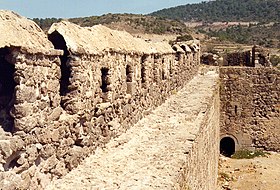Babakale
| Babakale | ||||
|
||||
 Fortress walls in Babakale |
||||
| Basic data | ||||
|---|---|---|---|---|
| Province (il) : | Çanakkale | |||
| District ( ilçe ) : | Ayvacık | |||
| Coordinates : | 39 ° 29 ' N , 26 ° 4' E | |||
| Residents : | 476 (2012) | |||
| Telephone code : | (+90) 286 | |||
| Postal code : | 17860 | |||
| License plate : | 17th | |||
| Structure and administration (as of 2016) | ||||
| Mayor : | Aziz Erkan | |||
Babakale (Turkish for father's castle ) is a place in the Ayvacık district in the Turkish province of Çanakkale . It is located in the ancient landscape of Troas at Cape Baba ( Bababurun in Turkish , Cape Lekton in ancient times ), nine kilometers southwest of Gülpınar , at the westernmost point of mainland Asia Minor . This makes Babakale the westernmost mainland point on the Asian continent .
The inhabitants live mainly from fishing, olive growing and, to a lesser extent, but increasingly from tourism.
fortress
The main attraction of the fishing village Babakale is the fortress, which was built in 1725 by Mustafa Pasha, a vizier of Sultan Ahmet III. was built as protection against pirates. It is the last Ottoman fortress to be built in Turkey. Mustafa, called Baba (Turkish for father ), is also the namesake of the place.
history
The ancient name of the place is Hamaxitos ( Ἁμάξιτος ), which is mentioned by Strabo . The city was probably founded by the Achaeans . From the fourth century BC Coins are known with the inscription ΑΜΑΞΙ and the image of Apollo . The latter refers to the nearby sanctuary of Apollon Smintheus in Chryse near today's Gülpinar. Hamaxitos was a member of the Deli-Attic Sea League . It became 397 BC. Conquered by the Spartan Derkyllidas . 310 BC BC Lysimachus deported the inhabitants to Antigoneia, the later Alexandria Troas . This probably ended the history of the city, of which no relics can be seen today.
Mouse legend
In Hamaxitos, as in other parts of the Troas, mice were worshiped, which is why Apollon had the nickname Smintheus (Greek about mouse devourer ) in the aforementioned sanctuary . Strabo tells the legend according to which the Teukrers were prophesied when they set out from Crete that they should settle where the earth-born would attack them. When they landed at Hamaxitos, the leather parts of their armor and weapons were gnawed off by field mice during the night. They took this as the said sign and settled here. Therefore, according to Strabon, the representation of a mouse at the foot of the Apollo statue of Scopas in Chryse is justified .
Web links
Individual evidence
- ↑ Yerelnet , accessed March 23, 2016
- ↑ Lonely Planet Turkey , p. 223 in the Google book search.
- ↑ Strabon 13,1,62 ( German translation in the Google book search).
- ↑ Gernot Lang: Classical Ancient Sites Anatolia , Books on Demand 2003, p. 414 in the Google book search, ISBN 3833000686 .
- ^ Carl Hoeck: Crete. An attempt to shed light on the mythology and history of the religion and constitution of this island . 1828, p. 273 in the Google book search.


